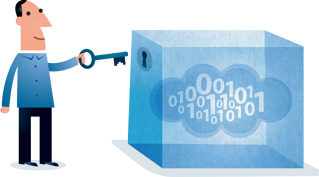7. The Importance of Data In A Communications Strategy
Knowing the difference between being good and bad is, well... good.
In a previous rambling, I blathered on about communication strategies and how the most effective communication in today's environment is one that is personal, relevant and timely.
Let's chat a little bit more about the personal part of the communication and what that really means. First, let's all agree on two basic points:
Personalization is good
Creepy is bad.
There can be a somewhat-fine line between personal and predatory. Howzabout we do a quick review...
Personal: Referring to the recipient in communication by their first name
Creepy: Mentioning their children's birthdates
Personal: Reaching out to participants to get them prepared for the race
Creepy: Reaching out to their emergency contacts to be ready for a call
Using Data for Personalization
If you haven’t figured it out yet, the data you have from your consumers is very valuable. Very. View it and use it in the right way and you can uncover channels to generate more revenue, methods to improve your sales and opportunities to get new partners.
Just by the mere fact of me buying your product, you should be generating a tremendous amount of my personal data. The question is, are you collecting that data and, if so, how will you use it.
Of all the data consumers can give you, most of you only use one data point: email address
The Math Around Marketing
Let's do a little basic math around your marketing outreach, shall we.
We'll assume you have 5,000 people who bought your products last year. The average form has about 15 fields. This includes the basic fields (name, dob, gender, location, email, etc.) and one or two custom questions.
5,000 people filling out 15 fields = 75,000 data points that you have available.
If you're just emailing people and telling them to register, you are only leveraging 6% of the data you have (only email address). On top of that, your "for goodness sakes, buy more stuff now" email (which I'm sure looks really pretty and has awesome wording), will only be opened by 1 in 4 of the people.
Of all the 5,000 people you emailed, most likely 4,850 of them are going to hit delete on that message without clicking anything.
So by only emailing people about your product without leveraging any personal data, you're using 6% of your available data with the hope that a whopping 150 people actually click a link and maybe one or two of them gives you money. Way to go.
It’s Not About You
Here’s the funny thing you may not know, if you use the data intelligently, your participants will be eager to give you even more data about themselves. (OK, maybe that's not funny... but you know what I mean. Stop giving me a hard time).
I don't know about you, but I get around 300 emails per day. For me to read an email, it's got to mean something to me. If it's marketing related, it has to be personal, relevant and timely. Otherwise, I just don't care.
<delete email within 1 second>
You really need to fully grasp that consumer’s mindset in order to determine your communication strategy, because that's where the other data points you're not using (the ones besides email) prove to be highly valuable. The more you know about me, the consumer, the more you can help me achieve my goals and make me feel special.
What You Should Know About Me From My Data
You should know if it’s the first time I’ve ever purchased from you, so you can give me insight into your company brand, your story and your purpose.
You should know what type of persona I probably am by the product I am buying, which enables you to cater other products to my persona.
You should know, through my social login, if I have other friends who have purchased products from you, so I can get social validation to spend more with you.
You should know that I feel great when I get a personal text message from somebody at the company about what I just bought and who I can contact for help. You should pretend like you know me and I’m important.
You should know if I respond better over email or text.
You should know all of this from the data that I've given you.
Don’t Freak Out Over Communication
You might be reading all of this and thinking "oh crap, how do I even get that data and how the heck do I find time to use it?".
Well, let's all just calm down for a minute or two. Get out a paper bag, stick your face in it and take a few big breaths (it's probably better to take the tortilla chips out of the bag before you do that).
What all of this means is that you should have a goldmine of data at your fingertips and you should spend a few hours coming up with a company wide communication strategy. That strategy should revolve around how you are going to use personal data to connect with your participants. That strategy should be the marching orders for the entire company and the interaction with consumers. If you know what you want to do, getting the data and utilizing it is the easy part.
Here’s my point….
Personalization isn’t an email. It’s a communications strategy
Use data to enhance your consumers journey
Give to get. If you give the consumers value, they will give you more info about themselves
It’s not about you, it’s about each individual consumer’s experience
I'm going to shut up now so you can start thinking about how you're going to change your communications.
Leave your thoughts in the comments section, would ya.





